Most articles you’ll find about running standups remotely detail how to do it via video (i.e. Zoom). It seems logical: you normally do standups in person, looking at everyone’s faces, so why not do them remotely with a video call, also looking at everyone’s faces.
But posts about this topic often overlook the fact that video calls present several problems for remote teams who run online daily scrums:
#1: Different Time Zones
Video standups require all team members to be there at the same time. But time zone and personal work schedule differences can make it difficult to schedule a daily meeting time that is convenient for everyone. This is especially true for larger teams (i.e. 12 people spread over 7 timezones).
#2: Takes Too Much Time
Video standups can run too long. Just like in-person standups, they often turn into lengthy problem-solving sessions. Or someone starts rambling about a trivial issue with no end in sight. So a 15 minute team meeting could turn into 30 minutes, leaving teammates frustrated since they just want to get back to work.
#3: Sitting Through Updates That Are Unrelated to Your Own Work
Standup attendees may have to sit through long updates that don’t apply to them (especially common in larger teams). For example, in an 8 person standup, someone may only need to hear an update from 2 people, not all eight. Naturally, folks get bored listening to info that doesn’t pertain to them. So they check out mentally for the rest of the meeting and stop listening or sharing. This of course cannibalizes the main benefit of standups: people getting in sync.
#4: Network Issues
It’s always frustrating when you experience internet connection issues during a video call. Folks keep getting disconnected from the meeting. And the audio may get so choppy that you can’t hear a teammate’s important update. So time is wasted… the teammate has to repeat the update again or just switch to chat if the connection doesn’t improve.
#5: Video Standups May Intimidate Introverts & Exhaust Them
Video standups can stress out introverts because they might not feel comfortable speaking in front of the whole team. They prefer sharing updates via text. Extroverts may leave video calls full of energy and excitement. But introverts could feel completely drained afterwards and no longer able to focus on meaningful work.
#6: Disrupts Workflow
Team members may have to stop working and break out of a flow to attend a video call standup that is set at a specific time. There’s nothing worse than getting in the zone while coding… and then having to drop everything you’re doing to attend a meeting.
We faced these problems ourselves before building Geekbot, a tool that lets teams run asynchronous standup meetings inside Slack.
Geekbot is actually our 4th startup as a team. Back in 2014, we were a team of 7 working remotely with no shared office.
We ran standups everyday via Zoom and there was a huge time cost involved in getting all 7 teammates on the same call at a specific time. Sometimes, it was just impossible due to calendar clashes & time zone differences. To add to that, we’d often get off track (i.e. water cooler chat or long code reviews) so our standup meetings would occasionally overrun by as much as 1 hour.
Clearly, standup video calls were a major pain point for us.
So we decided to build Geekbot for our own use. And eventually we released it to the public.
Since 2015, 100,000 users and companies like GitHub, Shopify, Airbnb, GitLab, and more have signed up for our Slack standup bot. Zapier even published a post on their blog about how their Strategic Apps team uses Geekbot everyday to run standups “in a timely manner” that is “minimally disruptive” (2 of the main reasons we also use Geekbot everyday ourselves).
In this post, we’ll show you how to run remote daily standups in Slack (via our product) and why it avoids the pitfalls listed above with video remote standups, making them more efficient & productive.
Table of Contents:
- Logistics: How to Run Remote Daily Standups in Slack
- Main Benefits of Running Daily Remote Standups in Slack (Instead of Video Calls)
- Shortens Standups
- Side Discussions (Without Involving Every Single Teammate)
- Asynchronous Communication (Time and Location Agnostic)
- Doesn’t Disrupt Workflow (Answer When It’s Convenient for You)
- Transparency & Accountability (Aligns Your Remote Company and Keeps Everyone in the Loop)
- Archives (Written Record & Searchable History)
- Teams Could Use Slack-Based Standup Meetings Alongside Video Meetings (Meeting Prep)
- How to Improve Team Bonding with Slack-Based Remote Meetings
Geekbot lets teams replace tedious in-person standups with efficient, transparent standup meetings in Slack. Learn more here and try it free for 30 days.
Logistics: How to Run Remote Daily Standups in Slack
Geekbot sends a direct message to standup participants in Slack, asking them to answer the 3 daily scrum questions:
- What did you do yesterday?
- What will you do today?
- Anything blocking your progress?
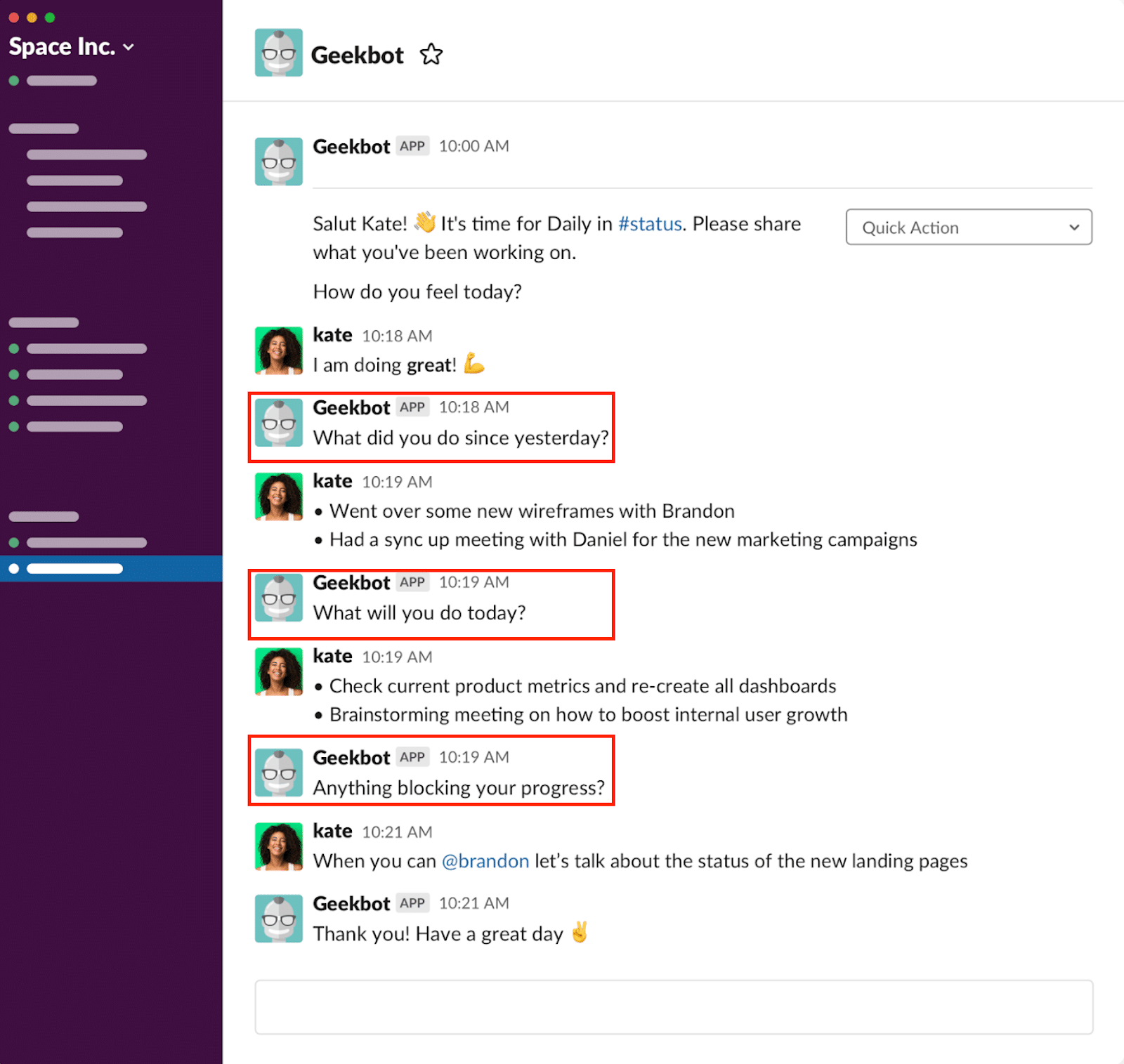
The team’s answers are then posted in a public Slack channel of your choosing:
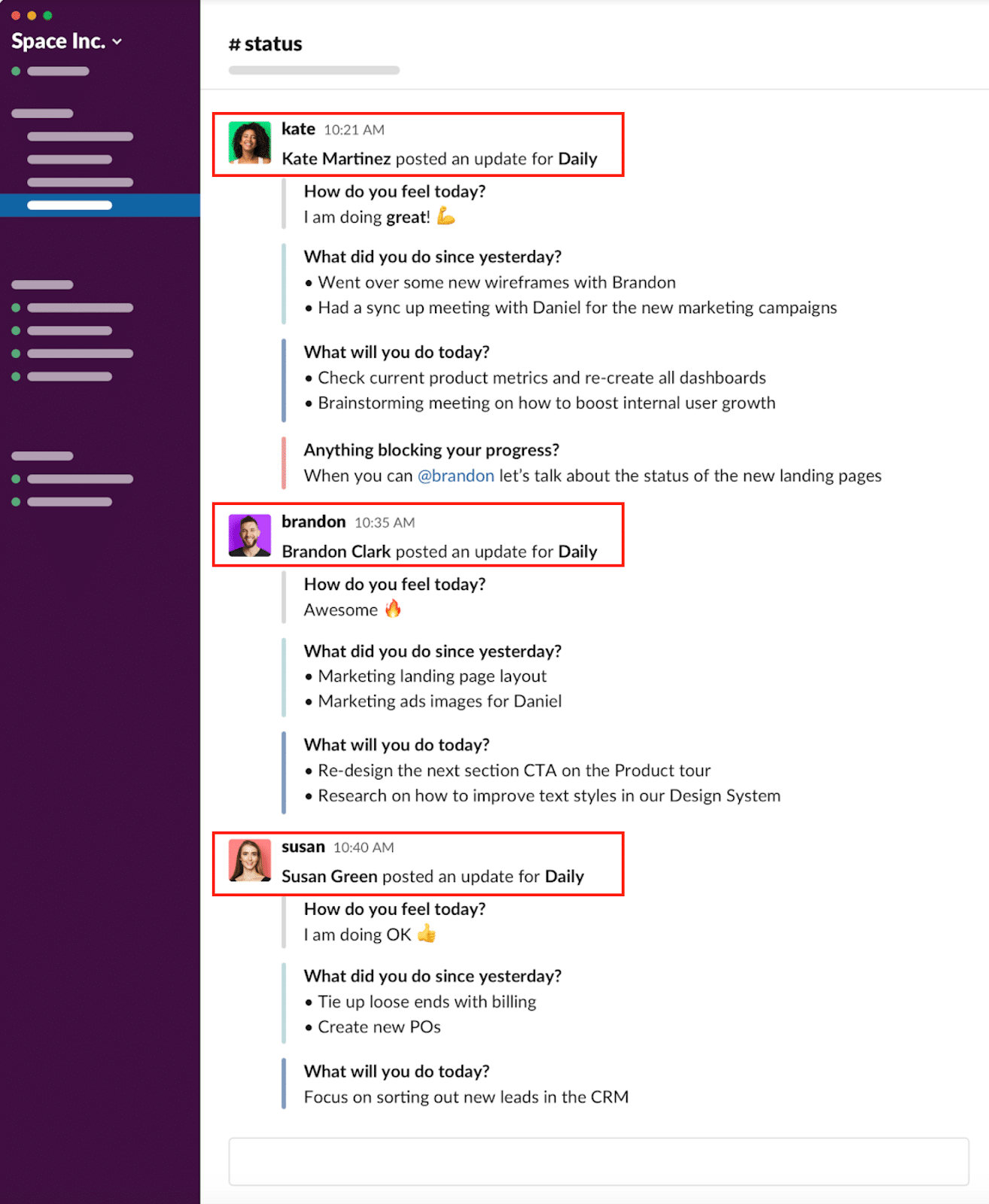
This achieves the core goal of a daily standup: to quickly and efficiently get updates and blockers from everyone on the team.
Geekbot runs each participant’s standup asynchronously. You can set up Geekbot to contact standup members at their own respective time zones:

You can choose when to schedule your standups (period & days):
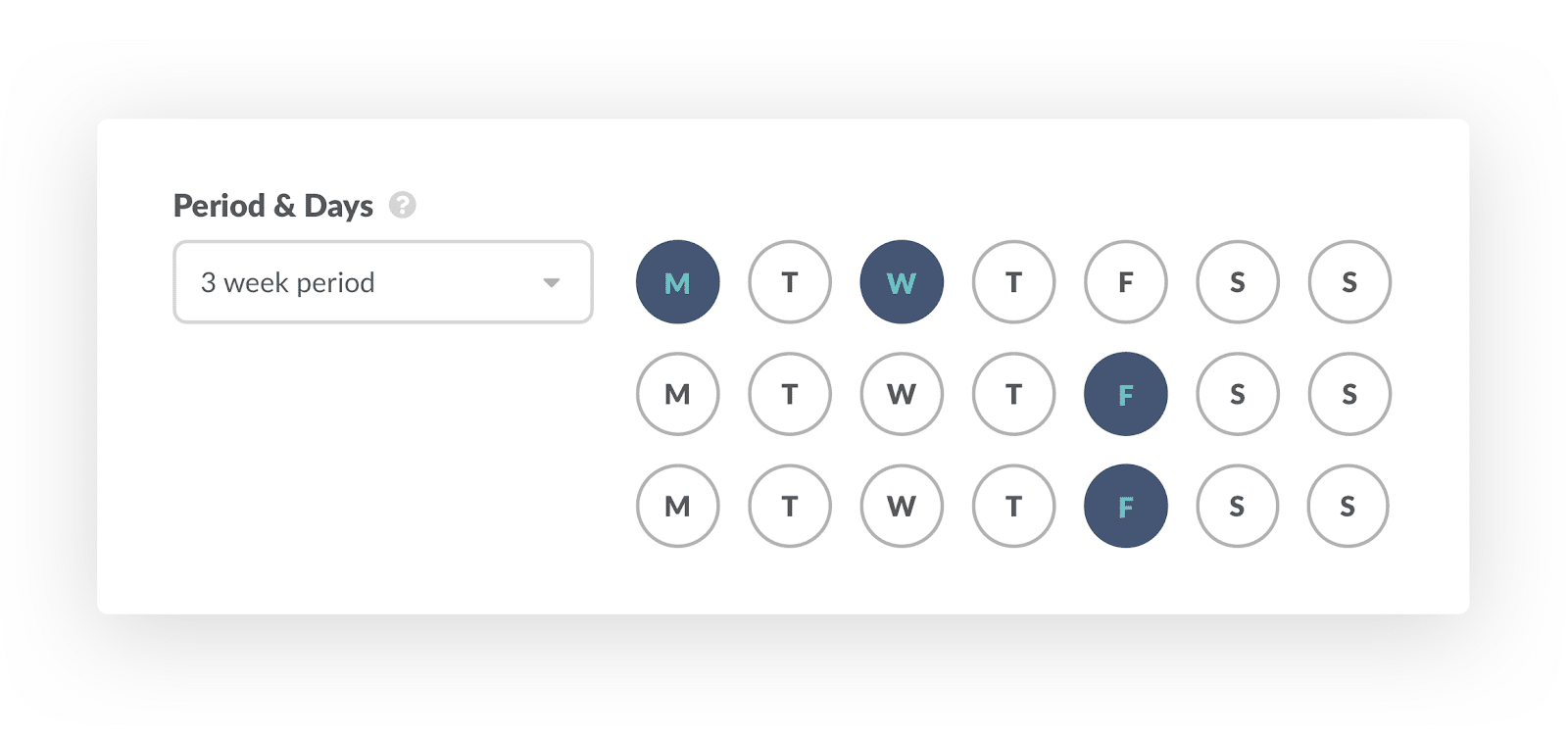
Everyone can answer the questions at any point during the day (not obligated to complete the standup at a specific, inconvenient time that disrupts your workday).
If standup participants forget to complete their answers, they can set up Geekbot to send them reminders in Slack (optional). Each member can choose their own follow-up reminder frequency:
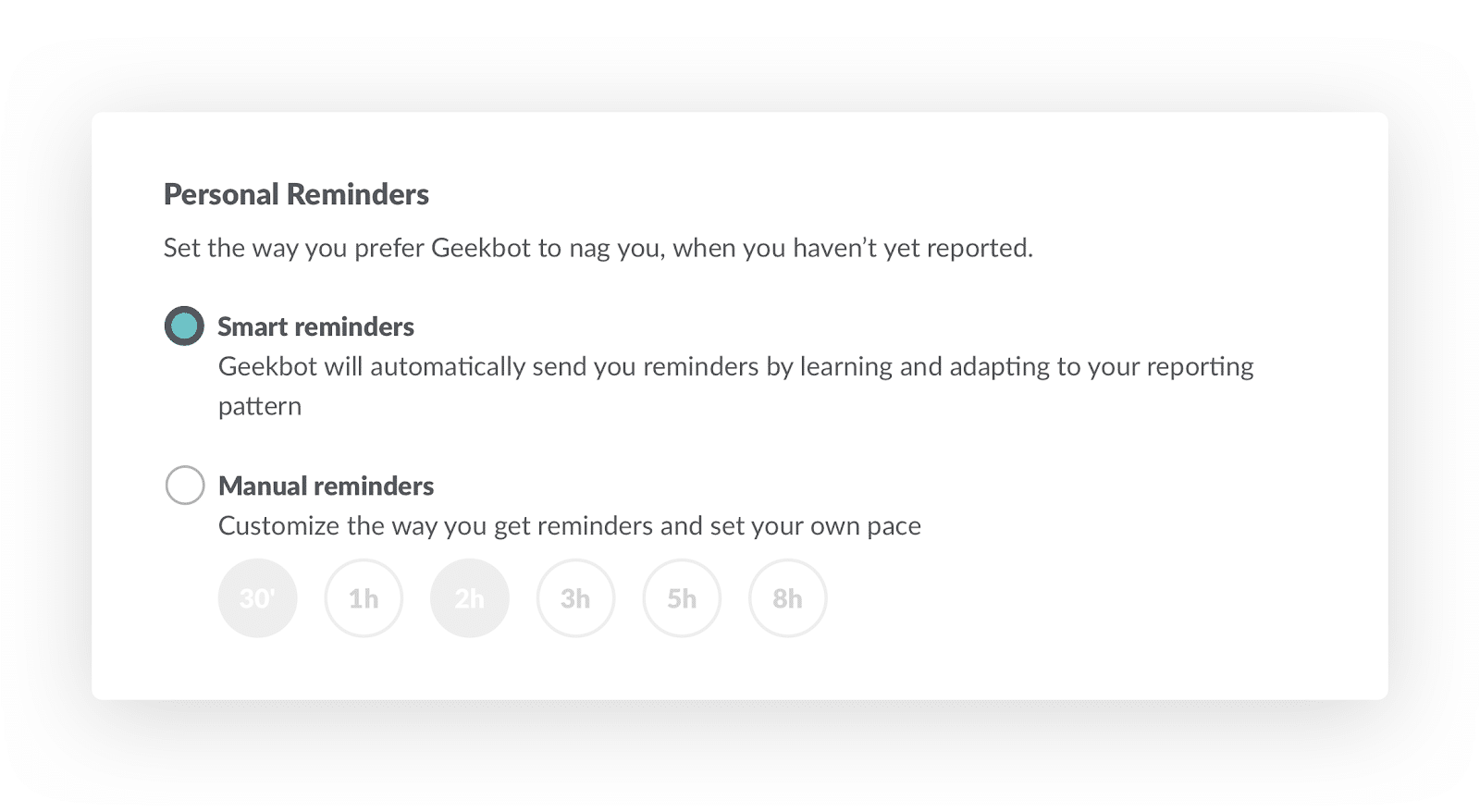
We just briefly touched on the most essential parts of the tool. But Geekbot offers a lot more functionality, features, and customizable standup settings.
Below is a quick 4 minute video that shows how to create your first standup in Geekbot (also provides more detail on how the tool works):
Main Benefits of Running Daily Remote Standups in Slack (Instead of Video Calls)
#1. Shortens Standups
The main (and most obvious) benefit of running daily standups via Slack is that it shortens daily scrums.
The whole standup process usually takes a total of 5 mins or less in Slack. It’s efficient and concise. You just:
- Quickly type in your answers.
- View all your teammate’s standup answers in a public Slack channel.
- Skim long status updates instead of listening to every single word (like in video conferencing calls).
- Do a quick run-through and see which answers are relevant to you.
- Pitch in with a comment and open up a Slack thread if needed… Or move on with your day if the updates don’t have anything to do with you.
It’s a relatively quick process.
In comparison, most development teams we’ve spoken to complete video conference standups (e.g. Zoom) in 15 mins (on a good day). And meetings often overrun due to water cooler chat, code reviews, long decision making, unnecessary rambling, etc.
These long video calls add up over time, leaving folks less time for meaningful work.
#2. Side Discussions (Without Involving Every Single Teammate)
In Slack, you can have detailed, productive problem solving side discussions without wasting anyone’s time via threaded conversation:
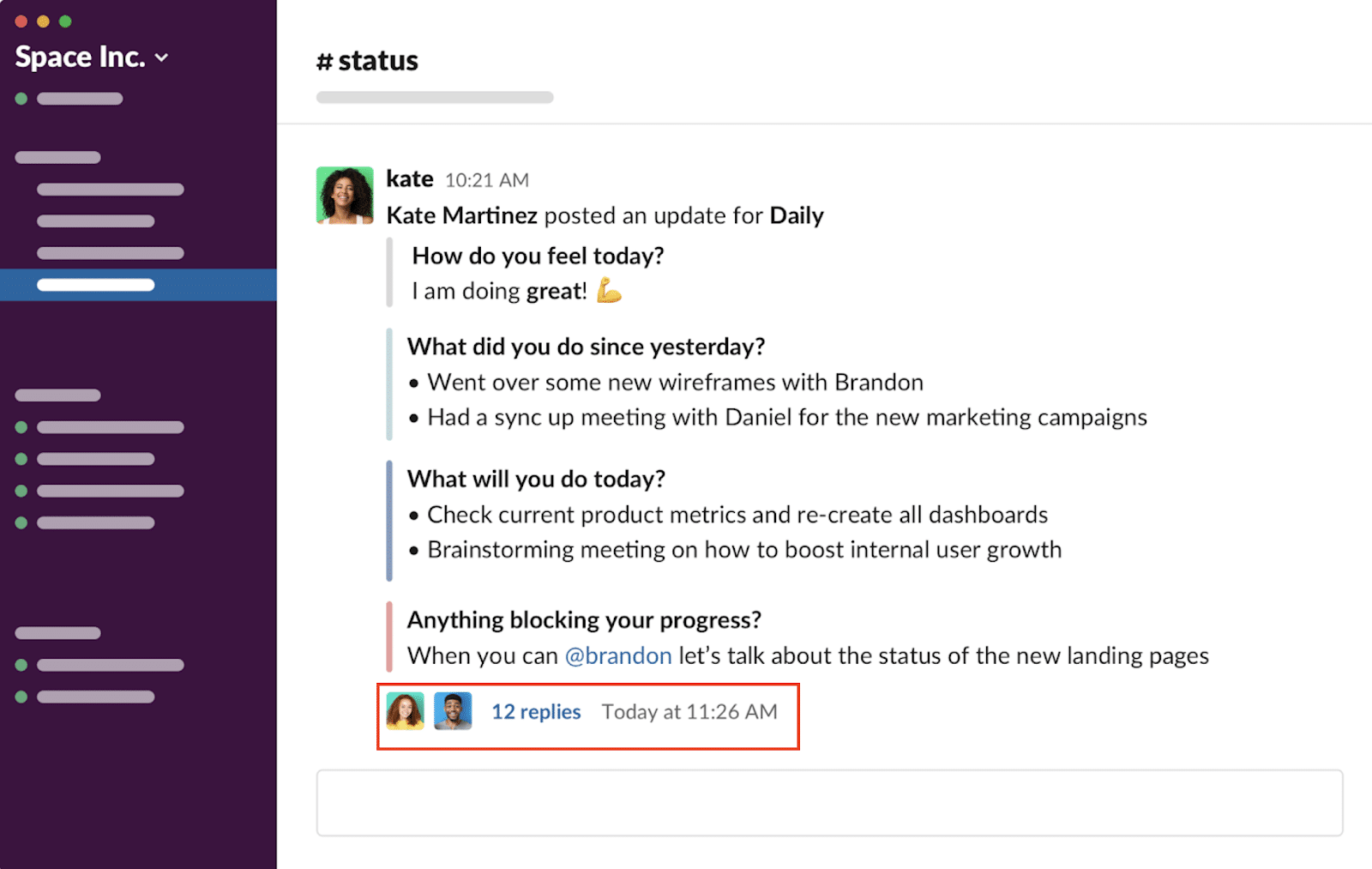
Folks can communicate with each other about a specific problem/roadblock that only involves them. The rest of the team doesn’t have to sit through & listen to discussions that aren’t relevant to their own work (like in video calls), but the team members dealing with an issue can still get into extended discussions to make progress on the issue.
In our view, it’s the best of both worlds. In the midst of an extended side discussion on a particular “blocker”, folks can also quickly get on a call to discuss more deeply.
#3. Asynchronous Meetings (Time and Location Agnostic)
As we mentioned earlier, you can go into Geekbot’s settings and choose the standup time and timezone:

Let’s say you configure the standup time to 12:25 PM but your team is spread across 4 different time zones. If you select “User’s local timezone”, then Geekbot will prompt teammates to answer questions at 12:25 PM in their own respective time zone.
That way, distributed teams don’t have to hop on video calls at odd hours that might be convenient for some folks, but inconvenient for others in a different time zone.
#4. Doesn’t Disrupt Workflow (Answer When It’s Convenient for You)
When Geekbot prompts you to answer the standup questions at a specific time, you don’t have to do it right away (there are no time limits).
You can answer at any time that is convenient for you and doesn’t disrupt your workday (i.e. after you’re done with a specific task/project, and not right in the middle of it).
In comparison, with video call standups, you might be in the zone and coding for the last 2 hours. But if a meeting is set to start in 10 mins, then you have to drop everything you’re doing and break out of a flow to attend.
As we mentioned earlier, you could set how often Geekbot sends you reminders when you haven’t completed the answers.
For example, if a standup starts at 2:00 PM, then you can set the first reminder to go out after half an hour, and the second reminder to go out after 2 hours:

However, by default, Geekbot reminders are turned off — you have to activate this option in your settings.
One of our customers wrote a relevant Geekbot review on Capterra about the non-intrusive nature of our bot (see highlighted orange part).
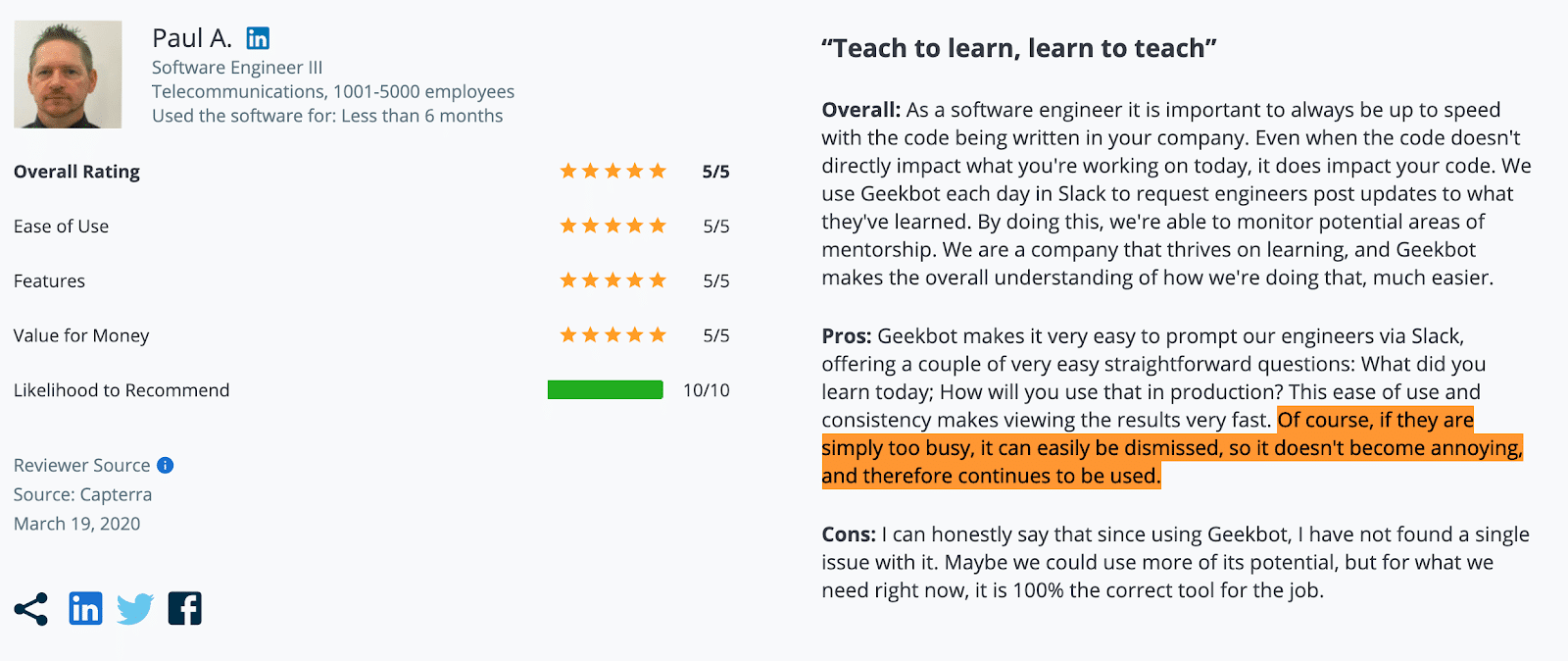
#5. Transparency & Accountability (Aligns Your Team and Keeps Everyone in the Loop)
Geekbot posts the standup answers in a public Slack channel that the entire team can see. The obvious benefit is that it keeps folks accountable/on the same page.
But there’s more to it:
You can stay up to date on what other teams in your company are working on (not just your own team). It eliminates the need for Scrum of Scrums.
Below are a few relevant, highlighted quotes (in orange) about transparency & accountability from some of Geekbot’s 51 Capterra reviews:
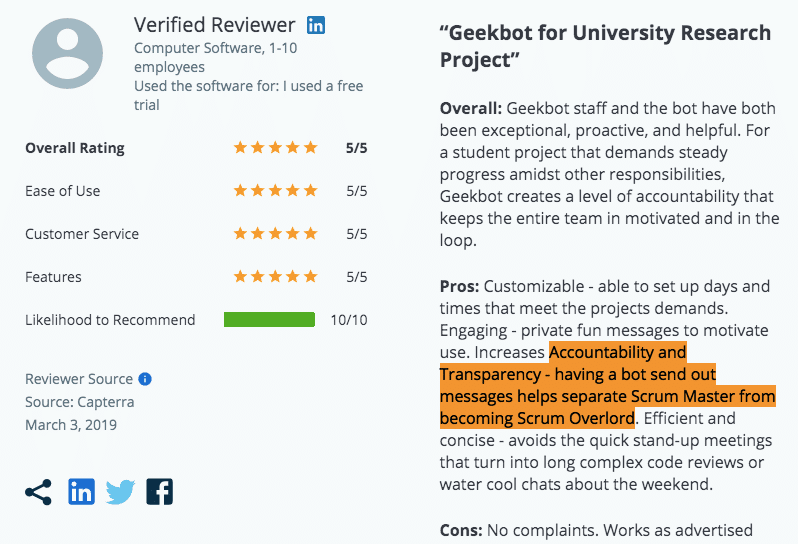

#6. Archives (Written Record & Searchable History)
This is a unique benefit to standups being conducted in Slack. You can go back in time and see a written (and searchable) history of your team’s standup answers.
There are a few benefits to having a searchable archive:
- Comes in handy if you forget what someone is working on. Managers can easily review past answers to see how the week or month has gone or why a particular project may have taken longer than expected.
- Scrum teams can analyze projects to see what went wrong (i.e. lack of communication) and avoid similar mistakes in the future.
- Some Geekbot customers use the written record to run better retrospectives.
- Product managers can also use archives to evaluate an employee’s performance & progress over time.
You can find past answers via:
- Slack channel where the answers are normally posted.
- Geekbot’s dashboard (filter by specific dates and times).
- CSV file (downloadable in Geekbot’s dashboard).
- Webhooks or Geekbot’s API (send answer data to products like GitLab, Trello, Jira, and so on).
- Geekbot can integrate seamlessly to all the regular tools your team uses on a daily basis. You’re not limited, and you can design the perfect workflow that works for you using Webhooks/API.
- You can also choose to receive standup summaries via email:
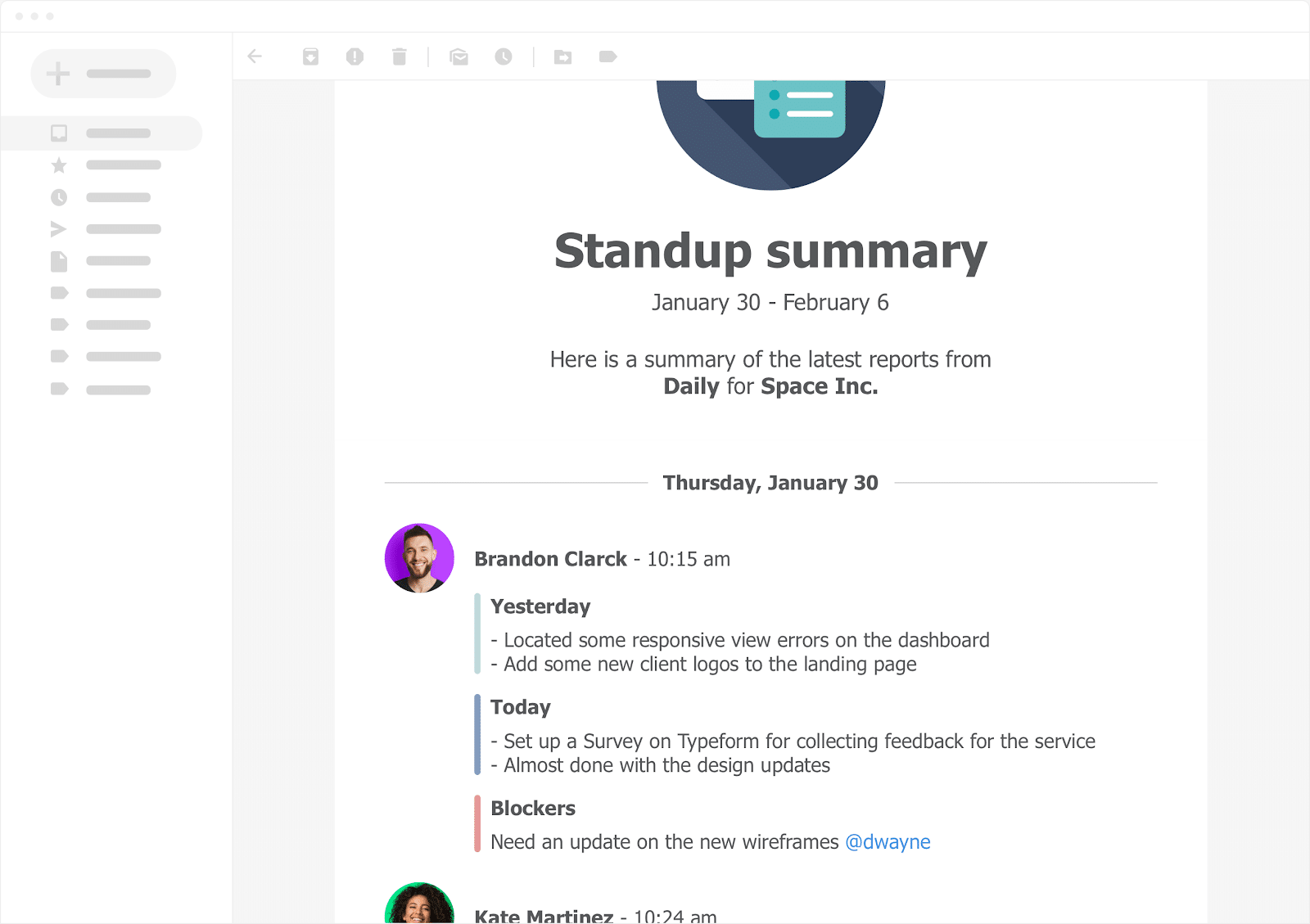
And choose the frequency of email summaries:
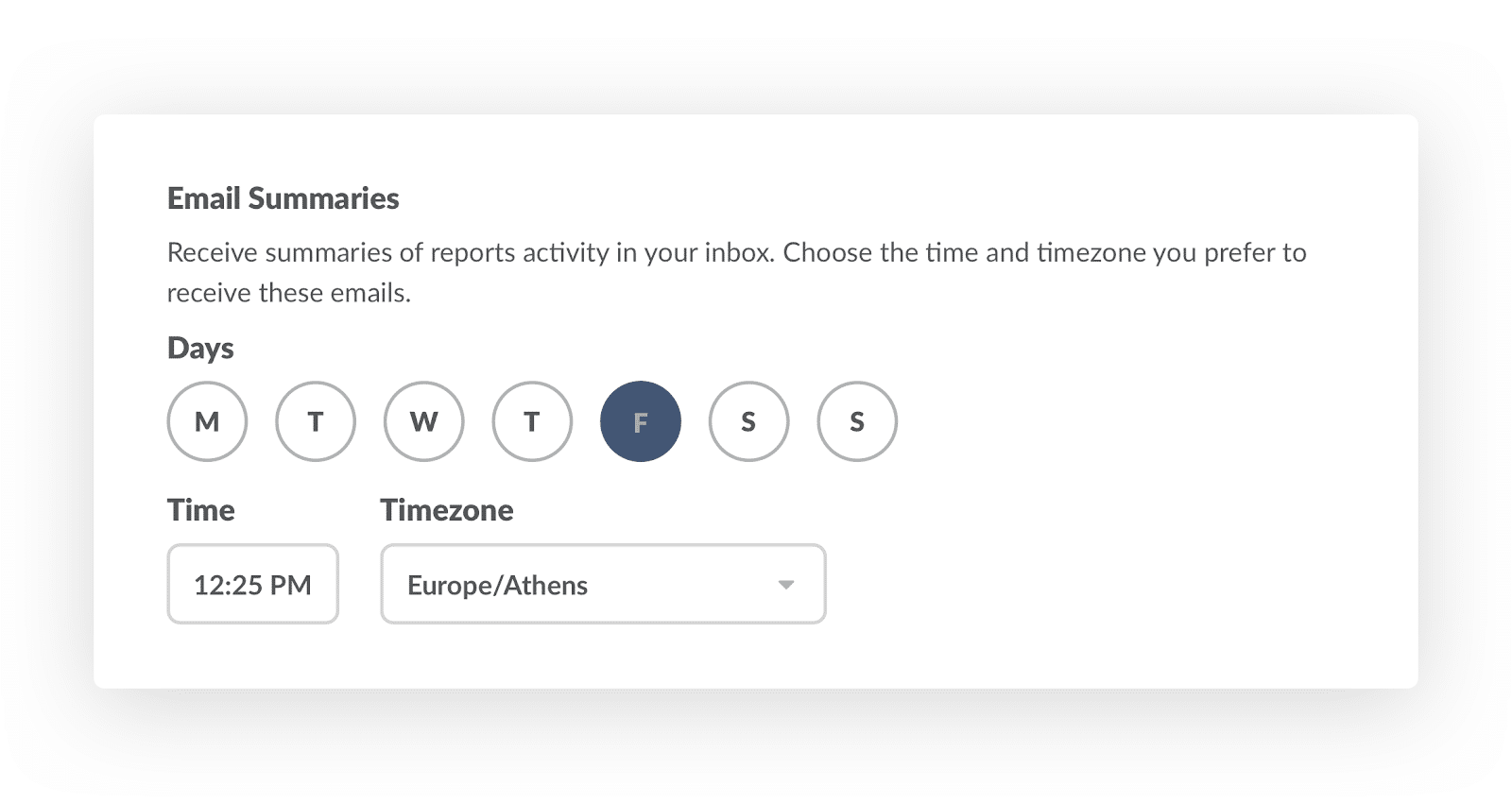
#7. Teams Could Use Slack-Based Standup Meetings Alongside Video Meetings (Meeting Prep)
We’ve seen several teams use our Geekbot + Slack as a video call prep/outline to shorten meetings. You can set up Geekbot to send the meeting prep questions in Slack 30 minutes before the call (questions are completely customizable).
People’s answers get posted in Slack. Then, the team can refer to the written updates and quickly address them in a Zoom or Google Hangouts meeting.
Teammates don’t have to speak for a long time and explain their updates if everything is already written beforehand. They can focus the video meeting on the most important discussion points, not just a long stream of updates.
How to Improve Team Bonding with Slack-Based Remote Meetings
One could make the argument that daily scrums in Slack aren’t as personal as video calls & don’t promote team bonding.
But if you’re an agile team that runs standups everyday, those long Zoom or Hangout meetings add up over time and take time away from tasks. So there’s a tradeoff between greater team bonding with video calls VS saving time with Geekbot.
That being said, you can still use Geekbot to achieve the team bonding function of standups in a few ways:
1. You can go into Geekbot’s settings and alter the 3 default standup questions. Some of our customers add a “How do you feel?” question at the start of each standup:

This check-in question gives insight into team morale & happiness. For example, is anyone feeling overloaded or stressed out today? Any personal issues that could affect someone’s work?
Geekbot can even analyze natural language responses for standup questions like “How do you feel?” and produce a team happiness graph:
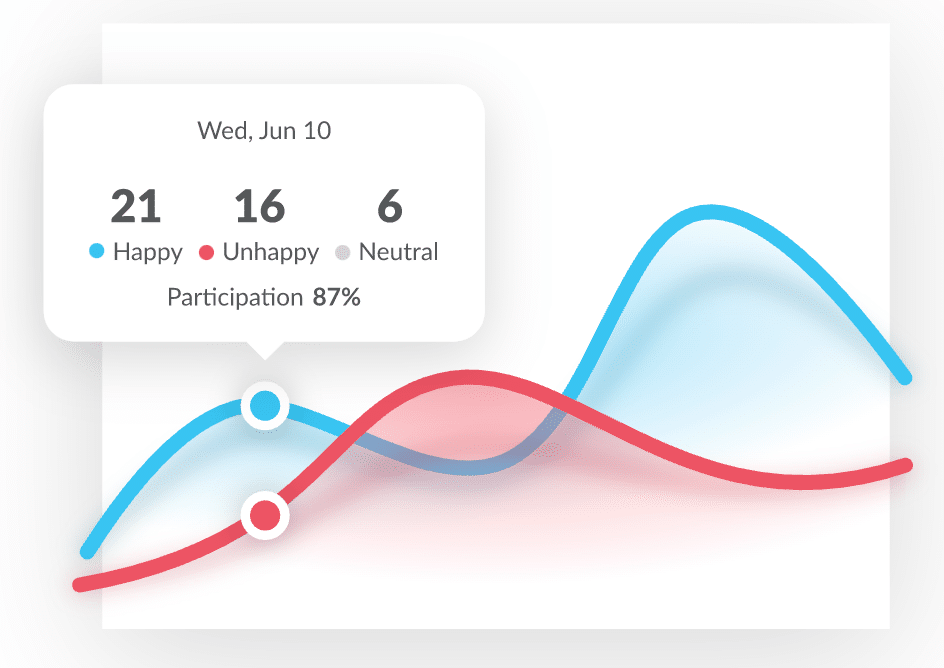
In talking with customers, we also found that some of them use the following question in Monday standups:
“What did you do this weekend?”
2. We also have a preset/feature called “Pizza Toppings”, where our Slack standup bot sends out random, fun team bonding questions like:
- What is your favorite movie?
- What shows are you watching right now?
- What is your favorite type of Sandwich?
- Etc.
Answers then get posted in a public Slack channel and everyone can chime in with a comment if they’d like. Teammates get to know each other on a more personal level.
This is one of Geekbot’s most popular presets and some customers use it as a daily & habitual team bonding activity.
Geekbot lets teams replace tedious/long video call standups with efficient, transparent standup meetings in Slack. Join our 100,000 users and thousands of companies who use us like GitHub, Shopify, Airbnb, GitLab, and more. Sign up for a free 30 day trial of Geekbot here.
Frequently asked questions
What do you say in a daily standup?
As a participant in a daily standup meeting you need to share with your team three important things: 1. What did you do since the last standup meeting? 2. What are you going to do next? 3. Are there any challenges that currently prevent you from working on your objectives? It’s important for every standup participant to keep their answers short and focused.
How do you run an effective daily stand up meeting?
To run an effective stand up meeting you need to follow two important rules. First, your meetings need to be short. A typical stand up meeting lasts no longer than 15 and it’s critical to not drag the meeting for longer. Second, an effective standup meeting is only about sharing progress and challenges. If team members want more detailed discussion around certain issues, they need to schedule a follow up meeting.
What are the 3 questions asked at a Scrum standup meeting?
Although a particular phrasing may vary from team to team, here are the three questions that every team member needs to answer during a Scrum Standup meeting: 1. What have you completed since the last meeting? 2. What do you plan to finish by the next meeting? What is in your way?




